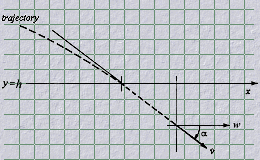Aerodynamic Drag Estimation |
The data set used in the "Parameter Estimation" example is not likely to be available in practical circumstances. However, a slight twist leads to a more efficient approach without the need for the intermediate trajectory data. To make the estimation of the coefficient of drag more realistic let's add a bit of a tail wind and a single "measurement" of the impact distance, say, 2000 meters. Note that the wind is resolved into a velocity vector to obtain a true velocity with respect to wind which is used in computation of the aerodynamic drag force. |
 |
In comparing the code with the "Parameter Estimation" case you'll note additional variation due to the replacement of trigonometric functions with their algebraic equivalents. |
|